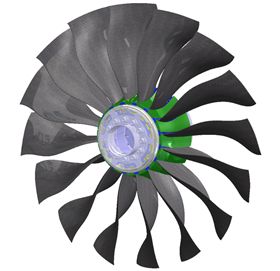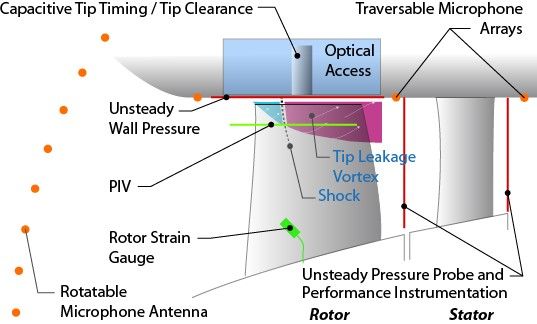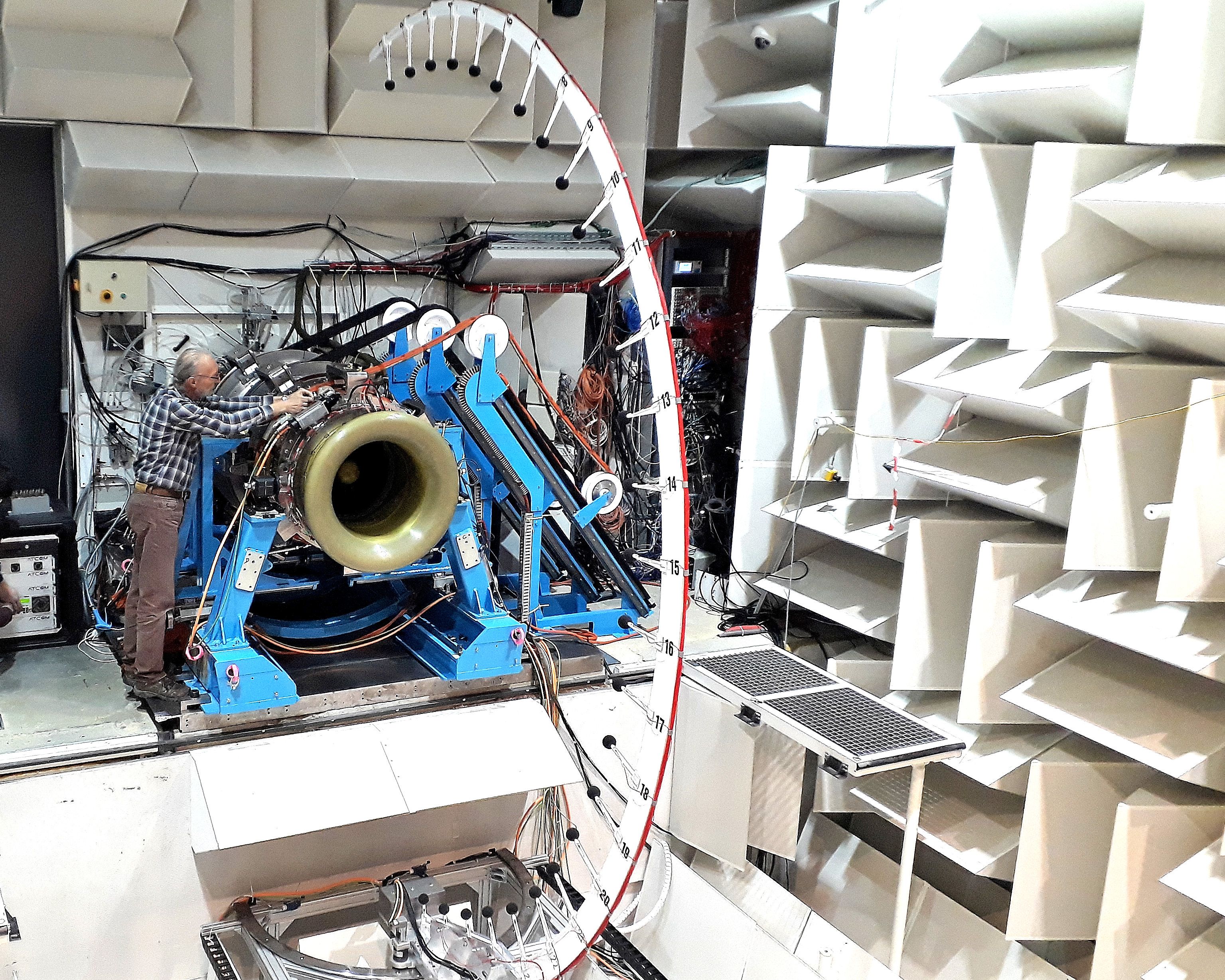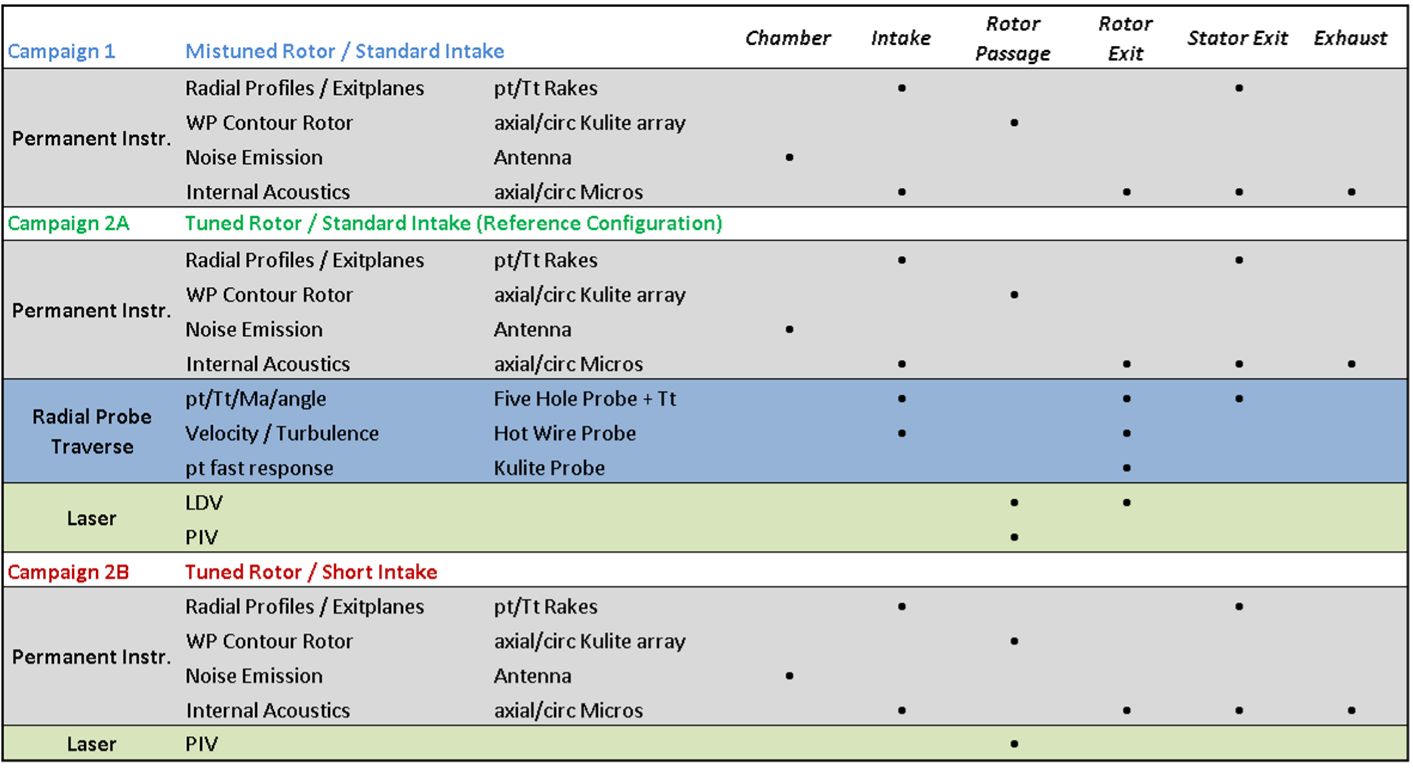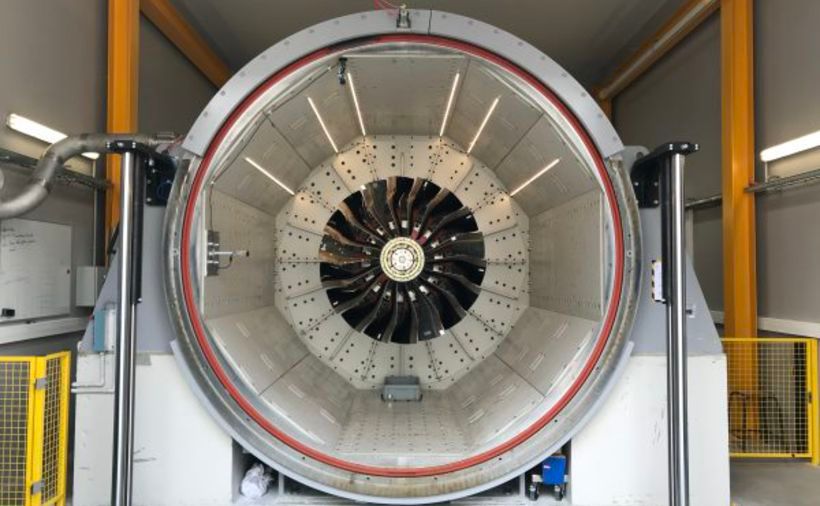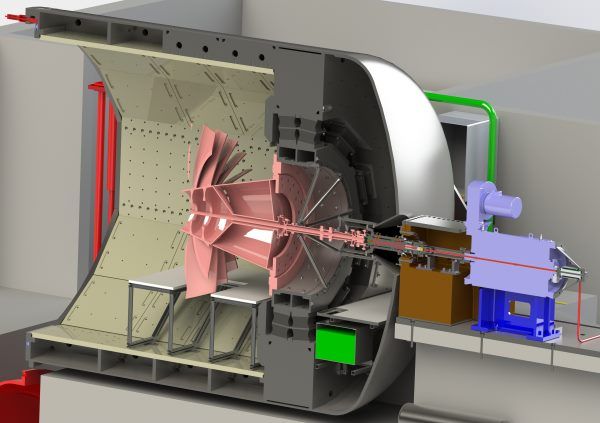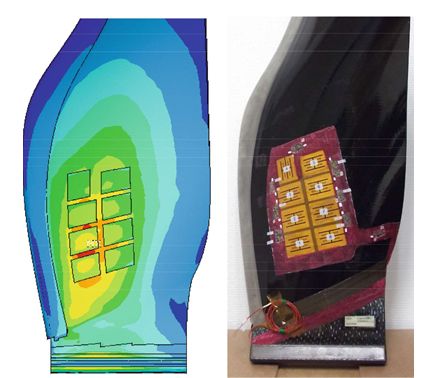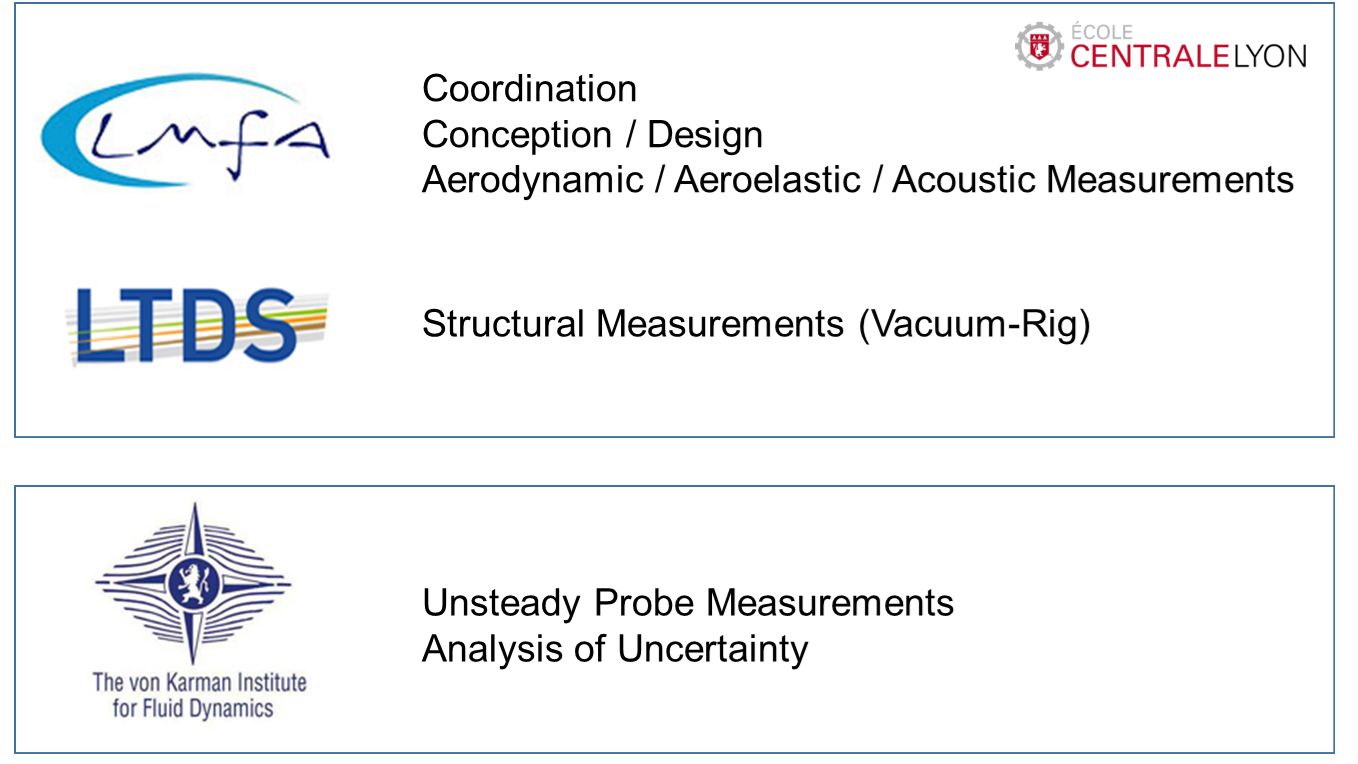Publications
Coupling Mechanisms and Instability
[1] Christoph BRANDSTETTER, Benoit PAOLETTI, Xavier OTTAVY. Compressible Modal Instability Onset in an Aerodynamically Mistuned Transonic Fan. ASME. J. Turbomach. 2018;():. doi:10.1115/1.4042310
[2] Pierre DUQUESNE, Q. RENDU, S. AUBERT, P. FERRAND. Choke flutter instability sources tracking with linearized calculations. International Journal of Numerical Methods for Heat & Fluid Flow (2018). DOI 10.1108/HFF-06-2018-0281
[3] Christoph BRANDSTETTER, Valdo PAGES, Pierre DUQUESNE, Benoit PAOLETTI, Stephane AUBERT, Xavier OTTAVY. (2018). Project PHARE-2 - a High-Speed UHBR Fan Test Facility for a new Open-Test-Case. 15th International Symposium on Unsteady Aerodynamics, Aeroacoustics & Aeroelasticity of Turbomachines, Oxford, UK
[4] Anne-Lise FIQUET, Christoph BRANDSTETTER, Stephane AUBERT, S., Mickael PHILIT. (2018). Non-Engine Order Oscillations in an Axial Multi-Stage Compressor - Acoustic Resonance. 15th International Symposium on Unsteady Aerodynamics, Aeroacoustics & Aeroelasticity of Turbomachines, Oxford,UK
[5] Pierre DUQUESNE, S. AUBERT, Q. RENDU, P. FERRAND. Effect of nodal diameter on the local blades vibration on the choke flutter instability in transonic UHBR fan. 15th International Symposium on Unsteady Aerodynamics, Aeroacoustics & Aeroelasticity of Turbomachines. University of Oxford, UK, September 2018
[6] Pierre DUQUESNE, S. AUBERT, Q. RENDU, P. FERRAND. Effect of frozen turbulence assumption on the local blades vibration on the choke flutter instability in transonic UHBR fan. IUTAM Symposium on Critical flow dynamics involving moving/deformable structures with design applications. Santorini, Greece, June 2018
[7] Pierre DUQUESNE, Q. RENDU, P. FERRAND, S. Aubert. Local contribution of blades vibration on the choke flutter instability in transonic UHBR fan. 53rd 3AF International Conference on Applied Aerodynamics: Multiphysics approach in Aerodynamics. Salon-de-Provence, France, 2018
[8] Victor MOËNNE-LOCCOZ, Isabelle TRÉBINJAC, Emmanuel BENICHOU, Sébastien GOGUEY, Benoît PAOLETTI, Pierre LAUCHER (2017). An experimental description of the flow in a centrifugal compressor from alternate stall to surge. J. Therm. Sci. 26, 289–296. doi:10.1007/s11630-017-0941-8
[9] Johannes SCHREIBER, Benoît PAOLETTI, Xavier OTTAVY (2017). Observations on rotating instabilities and spike type stall inception in a high-speed multistage compressor. Int. J. Rot. Machin. 2017, 7035870 (11 pages). doi:10.1155/2017/7035870
[10] Yannick BOUSQUET, Nicolas BINDER, Guillaume DUFOUR, Xavier CARBONNEAU, Isabelle TRÉBINJAC, Mathieu ROUMEAS (2016). Numerical investigation of Kelvin-Helmholtz instability in a centrifugal compressor operating near stall. J. Turbomach. 138, 071007 (9 pages). doi:10.1115/1.4032457
[11] Flore CREVEL, Nicolas GOURDAIN, Xavier OTTAVY (2014). Numerical simulation of aerodynamic instabilities in a multistage high-speed high-pressure compressor on its test rig - Part II: deep surge. J. Turbomach. 2014, 101004 (15 pages). doi:10.1115/1.4027968
[12] Flore CREVEL, Nicolas GOURDAIN, Stéphane MOREAU (2014). Numerical simulation of aerodynamic instabilities in a multistage high-speed high-pressure compressor on its test-rig - Part I : rotating stall. J. Turbomach. 136, 101003 (14 pages). doi:10.1115/1.4027967
[13] Nicolas COURTIADE, Xavier OTTAVY (2013). Experimental study of surge precursors in a high-speed multistage compressor. J. Turbomach. 135, 061018 (9 pages). doi:10.1115/1.4023462
[14] Nicolas COURTIADE, Xavier OTTAVY (2013). Study of the acoustic resonance occurring in a multistage high-speed axial compressor. Proc. IMechE Part A, J. Power Energy 227, 654–664. doi:10.1177/0957650913500493
[15] Nicolas COURTIADE, Xavier OTTAVY, Nicolas GOURDAIN (2012). Modal decomposition for the analysis of the rotor-stator interactions in multistage compressors. J. Therm. Sci. 21, 276–285. doi:10.1007/s11630-012-0545-2
[16] Nicolas GOURDAIN, Fabien WLASSOW, Xavier OTTAVY (2012). Effect of tip clearance dimensions and control of unsteady flows in a multi-stage high-pressure compressor. J. Turbomach. 134, 051005 (13 pages). doi:http://dx.doi.org/10.1115/1.4003815
[17] Xavier OTTAVY, Nicolas COURTIADE, Nicolas GOURDAIN (2012). Experimental and Computational Methods for Flow Investigation in High-Speed Multistage Compressor. J. Propul. Power 28, 1141–1155. doi:10.2514/1.60562
[18] Nicolas GOURDAIN, S. BURGUBURU, Francis LEBOEUF, G.J. MICHON (2010). Simulation of rotating stall in a whole stage of an axial compressor. Comput. Fluids 39, 1644–1655. doi:10.1016/j.compfluid.2010.05.017
[19] Guillaume LEGRAS, Nicolas GOURDAIN, Isabelle TRÉBINJAC (2010). Numerical analysis of the tip leakage flow field in a transonic axial compressor with circumferential casing treatment. J. Therm. Sci. 19, 198–205. doi:10.1007/s11630-010-0198
[20] Nicolas BULOT, Isabelle TRÉBINJAC (2009). Effect of the unsteadiness on the diffuser flow in a transonic centrifugal compressor stage. Int. J. Rot. Machin. 2009, 932593 (11 pages). doi:10.1155/2009/932593
[21] Nicolas BULOT, Isabelle TRÉBINJAC, Xavier OTTAVY, Pascale KULISA, G. HALTER, Benoît PAOLETTI, Patrick KRIKORIAN (2009). Experimental and numerical investigation of the flow field in a high-pressure centrifugal compressor impeller near surge. Proc. IMechE Part A, J. Power Energy 223, 657–666. doi:10.1243/09576509JPE817
[22] Nicolas GOURDAIN, Francis LEBOEUF (2009). Unsteady simulation of an axial compressor stage with casing and blade passive treatments. J. Turbomach. 131, 021013 (12 pages). doi:10.1115/1.2988156
[23] Isabelle TRÉBINJAC, Pascale KULISA, Nicolas BULOT, Nicolas ROCHUON (2009). Effect of unsteadiness on the performance of a transonic centrifugal compressor stage. J. Turbomach. 131, 041011 (9 pages). doi:10.1115/1.3070575
[24] Nicolas ROCHUON, Isabelle TRÉBINJAC, Pascale KULISA, G. BILLONNET (2008). Assessment of jet-wake flow structures induced by three-dimensional hub wall contouring. IREME 2, 113–121
[25] Nicolas BULOT, Isabelle TRÉBINJAC (2007). Impeller-diffuser interaction: analysis of the unsteady flow structures based on their direction of propagation. J. Therm. Sci. 16, 193–202. doi:10.1007/s11630-007-0193-0
[26] Isabelle TRÉBINJAC, Nicolas ROCHUON, G. BILLONNET (2006). An extraction of the dominant rotor-stator interaction modes by the use of Proper Orthogonal Decomposition (POD). J. Therm. Sci. 15, 109–114. doi:10.1007/s11630-006-0109-4
[27] Nicolas GOURDAIN, S. BURGUBURU, Francis LEBOEUF, H. MILTON (2006). Numerical simulation of rotating stall in a subsonic compressor. Aerosp. Sci. Technol. 10, 9–18. doi:10.1016/j.ast.2005.07.006
[28] Isabelle TRÉBINJAC, D. CHARBONNIER, Francis LEBOEUF (2005). Unsteady rotor-stator interaction in high speed compressor and turbine stages. J. Therm. Sci. 14, 289–297. doi:10.1007/s11630-005-0047-6
[29] Isabelle TRÉBINJAC, C. VIXEGE (2002). Experimental analysis of the rotor stator interaction within a high pressure centrifugal compressor. J. Therm. Sci. , 1–9. doi:10.1007/s11630-002-0014-4
[30] Xavier OTTAVY, Isabelle TRÉBINJAC, André VOUILLARMET (2001). Analysis of the inter-row flow field within a transonic axial compressor : Part 2 - Unsteady flow analysis. J. Turbomach. 123, 57–63. doi:10.1115/1.1328086
[31] Xavier OTTAVY, Isabelle TRÉBINJAC, André VOUILLARMET (2001). Analysis of the inter-row flow field within a transonic axial compressor : Part 1 - Experimental investigation. J. Turbomach. 123, 49–56. doi:10.1115/1.1328085
[32] BRANDSTETTER, C., JÜNGST, M., & SCHIFFER, H.-P. (2017). Measurements of Radial Vortices, Spill Forward and Vortex Breakdown in a Transonic Compressor. ASME. Journal of Turbomachinery. 140(6):061004 . doi: 10.1115/1.4039053
[33] BRANDSTETTER, C., & SCHIFFER, H.-P. (2017). PIV Measurements of the Transient Flow Structure in the Tip Region of a Transonic Compressor Near Stability Limit. Journal of the Global Power and Propulsion Society, doi: 10.22261/JGPPS.JYVUQD
[34] BRANDSTETTER, C., WARTZEK, F., WERNER, J., SCHIFFER, H.-P., & HEINICHEN, F. (2016). Unsteady Measurements of Periodic Effects in a Transonic Compressor With Casing Treatments. ASME. Journal of Turbomachinery, 138(5):051007. doi:10.1115/1.4032185
[35] BRANDSTETTER, C., HOLZINGER, F., SCHIFFER, H.-P., STAPELFELDT, S., & VAHDATI, M. (2016). Near Stall Behavior of a Transonic Compressor Rotor with Casing Treatment. ASME. Turbo Expo: Power for Land, Sea, and Air, Volume 2D: Turbomachinery: V02DT44A013., GT2016-56606. doi:10.1115/gt2016-56606
[36] BRANDSTETTER, C., KEGALJ, M., WARTZEK, F., HEINICHEN, F., & Schiffer, H.-P. (2014).Stereo PIV Measurement of Flow Structures underneath an Axial-Slot Casing Treatment on a One and a Half Stage Transonic Compressor. 17th International Symposium on Applications 2014, Lisbon, Portugal
[37] BRANDSTETTER, C., BIELA, C., KEGALJ, M., & SCHIFFER, H.-P. (2011). PIV-Measurements in a Transonic Compressor Test Rig with Variable Inlet Guide Vanes. Proceedings of 20th ISABE 2011, Gothenburg, Sweden
Analysis of individual phenomena in turbomachinery (ECL-LMFA)
[38] Feng GAO, Wei MA, Jinjing SUN, Jérôme BOUDET, Xavier OTTAVY, Yangwei LIU, Lipeng LU, Liang SHAO (2017). Parameter study on numerical simulation of corner separation in LMFA-NACA65 linear compressor cascade. Chin. J. Aeronauti. 30, 15–30. doi:10.1016/j.cja.2016.09.015
[39] Hongwei MA, Wei WEI, Xavier OTTAVY (2017). Experimental investigation of flow field in a laboratory-scale compressor Chin. J. Aeronauti. 30, 31–46. doi:10.1016/j.cja.2016.09.016
[40] Gherardo ZAMBONINI, Xavier OTTAVY, Jochen KRIEGSEIS (2017). Corner separation dynamics in a linear compressor cascade. J. Fluids Eng. 139, 061101 (13 pages). doi:10.1115/1.4035876
[41] Jérôme BOUDET, Joëlle CARO, Bo LI, Emmanuel JONDEAU, Marc C. JACOB (2016). Zonal large-eddy simulation of a tip leakage flow. Int. J. Aeroacoustics 15, 646–661. doi:10.1177/1475472X16659215
[42] Jérôme BOUDET, Adrien CAHUZAC, Philip KAUSCHE, Marc C. JACOB (2015). Zonal large-eddy simulation of a fan tip-clearance flow, with evidence of vortex wandering. J. Turbomach. 137, 061001 (9 pages). doi:10.1115/1.4028668
[43] Feng GAO, Wei MA, Gherardo ZAMBONINI, Jérôme BOUDET, Xavier OTTAVY, Lipeng LU, Liang SHAO (2015). Large-eddy simulation of 3-D corner separation in a linear compressor cascade. Phys. Fluids 27, 085105 (21 pages). doi:10.1063/1.4928246
[44] Feng GAO, Gherardo ZAMBONINI, Jérôme BOUDET, Xavier OTTAVY, Lipeng LU, Liang SHAO (2015). Unsteady behavior of corner separation in a compressor cascade: Large eddy simulation and experimental study. Proc. IMechE Part A, J. Power Energy 229, 508–519. doi:10.1177/0957650915594314
[45] Mehmet MERSINLIGIL, Jean-François BROUCKAERT, Nicolas COURTIADE, Xavier OTTAVY (2013). On using fast response pressure sensors in aerodynamic probes to measure total temperature and entropy generation in turbomachinery blade rows. J. Eng. Gas Turbine Power 135, 101601 (10 pages). doi: 10.1115/1.4024999
[46] Wei MA, Xavier OTTAVY, Lipeng LU, Francis LEBOEUF (2013). Intermittent corner separation in a linear compressor cascade. Exp. Fluids 54, 1–17. doi:10.1007/s00348-013-1546
[47] Julien MARTY, Lionel CASTILLON, J.-C. BONIFACE, S. BURGUBURU, Antoine GODARD (2013). Numerical and experimental investigations of flow control in axial compressors. Aerospace Lab Journal 6, 1–13
[48] William RIÉRA, Lionel CASTILLON, Julien MARTY, Francis LEBOEUF (2013). Inlet condition effects on the tip clearance flow with zonal detached eddy simulation. J. Turbomach. 136, 041018 (10 pages). doi:10.1115/1.4025216
[49] Mehmet MERSINLIGIL, Jean-François BROUCKAERT, Nicolas COURTIADE, Xavier OTTAVY (2012). A high temperature high bandwidth fast response total pressure probe for measurements in a multistage axial compressor. J. Eng. Gas Turbine Power 134, 061601. doi:10.1115/1.4006061
[50] Wei MA, Xavier OTTAVY, Lipeng LU, Francis LEBOEUF, Feng GAO (2011). Experimental study of corner stall in a linear compressor cascade. Chin. J. Aeronauti. 24, 235–242. doi:10.1016/S1000-9361(11)60028-9
[51] Nicolas BULOT, Xavier OTTAVY, Isabelle TRÉBINJAC (2010). Unsteady pressure measurements in a high-speed centrifugal compressor. J. Therm. Sci. 19, 1–8. doi:10.1007/s11630-010-0000-0
[52] Xavier OTTAVY, Isabelle TRÉBINJAC, André VOUILLARMET (1998). Treatment of L2F anemometer measurement volume distortions created by curved windows for turbomachinery application. Meas. Sci. Technol. 9, 1511–1521. doi:10.1088/0957-0233/9/9/021.
Structure Dynamics (ECL-LTDS)
[1] MABILIA A., GIBERT C., THOUVEREZ F., DE JAEGHERE E., SANCHEZ L., GIOVANNONI L., 2018, Modal Testing of a Full-Scale Rotating Woven Composite Fan Using Piezoelectric Excitation, 10th International Conference on Rotor Dynamics , 23/09/2018 - 27/09/2018, Rio de Janeiro - Brésil, oral, acte : Proceedings of the 10th International Conference on Rotor Dynamics – IFToMM, ISBN 978-3-319-99269-3, Springer International Publishing, 62, 291-305.
[2] MABILIA A., GIBERT C., THOUVEREZ F., De JAEGHERE E., 2018, Nonlinear Forced Response of a Composite Fan Blade Actuated by Piezoelectric Patches: Simulation and Testing, Nonlinear Dynamics, 1, 351-362.
[3] DUMARTINEIX C., CHOUVION B., THOUVEREZ F., Parent M.-O., 2018, An Efficient Approach for the Frequency Analysis of Non-Axisymmetric Rotating Structures: Application to a Coupled Bladed Bi-Rotor System, Journal of Engineering for Gas Turbines and Power, 1, 1-12.
[4] ALMEIDA P., GIBERT C., THOUVEREZ F., LEBLANC X., OUSTY J.-P., 2016, Numerical analysis of bladed disk-casing contact with friction and wear, Journal of Engineering for Gas Turbines and Power, 138, 12, 1-12.
[5] JOANNIN C., THOUVEREZ F., CHOUVION B., OUSTY J.-P., 2015, Nonlinear Modal Analysis of Mistuned Periodic Structures Subjected to Dry Friction, Journal of Engineering for Gas Turbines and Power, 138, 7, 1-17.
[6] THOUVEREZ F., GROLET A., GIBERT C., 2014, Non-linear periodic solutions of bladed disks, EURODYN 2014 9th International Conference on Structural Dynamics, 30/06/2014 - 02/07/2014, Porto - Portugal, oral, acte : Proceedings 9th International Conference on Structural Dynamics, 12 pages.
[7] ALMEIDA P., GIBERT C., LEBLANC X., OUSTY J.-P., THOUVEREZ F., 2012, Experimental and Numerical Investigations on a Rotating Centrifugal Compressor, ASME Gas Turbine Technical Congress & Exposition 2012, 09/11/2012 - 15/11/2012, Houston-États-Unis, oral, acte : ASME Gas Turbine Technical Congress & Exposition 2012, ISBN 978-0-7918-4520-2, 7, 1133-1142.
[8] PAYER F., FERRAND P., DUGEAI A., THOUVEREZ F., 2012, Comparison of Fluid-Structure Coupling Methods for Blade Forced Response Prediction, ASME 2012 Gas Turbine India Conference, 01/12/2012 - 01/12/2012, Maharashtra - Inde, oral, acte : ASME 2012 Gas Turbine India Conference, 595-602.
[9] GIBERT C., BLANC L., ALMEIDA P., LEBLANC X., OUSTY J.-P., Thouverez F., Lainé J.-P., 2012, Modal Tests and Analysis of a Radial Impeller at Rest: Influence of Surrounding Air on Damping, ASME Gas Turbine Technical Congress & Exposition 2012, 11/06/2012 - 15/06/2012, Copenhague - Danemark, oral, acte : ASME Turbo Expo 2012: Turbine Technical Conference and Exposition, 1121-1131.
[10] GIBERT C., KHARYTON V., THOUVEREZ F., JEAN P., 2010, On forced response of a rotating integrally bladed disk: Predictions and experiments, ASME Gas Turbine Technical Congress & Exposition 2010, 14/06/2010 - 18/06/2010, Glasgow - Royaume-Uni, oral, acte : Proceedings of ASME Turbo Expo: Power for Land, Sea and Air 2010, 6, 1103-1116.
[11] LAXALDE D., THOUVEREZ F., 2009, Complex Non-Linear Modal Analysis for Mechanical Systems: Application to Turbomachinery Bladings With Friction Interfaces, Journal of Sound and Vibration, 322, 4, 1009-1025.
[12] PICHOT F., LAXALDE D., SINOU J.J., THOUVEREZ F., LOMBARD J.P., “Mistuning identification for industrial blisks based on the based achievable eigenvector”, Computers & Structures, 84, 2033-2049, 2006.
Measurement Techniques / Uncertainty (VKI)
[1] BOUFIDI E., “On the Dynamic Response of Constant Temperature Hot Wire Anemometers (CTHWA)”, Symposium of VKI PhD Research 2018
[2] BOUFIDI E., COTTES M., FONTANETO F., “CTHWA dynamic response effects on turbulence measurements in turbomachinery flows”, XXIV Biannual Symposium on Measuring Techniques in Turbomachinery, Prague 29 - 31 August 2018
[3] BOUFIDI E., ALATI M., FONTANETO F., LAVAGNOLI S., “Design and testing of a miniaturized five-hole fast-response pressure probe with large frequency bandwidth and high angular sensitivity”, Proceedings of ASME Turbo Expo 2019, June 17 - 21, 2019 in Phoenix, Arizona USA
[4] BOUFIDI E., “Uncertainty Quantification of Turbulence Statistics Measured by Hot-Wire Anemometry”, Symposium of VKI PhD Research 2017
[5] BOUFIDI, E., LAVAGNOLI, S., FONTANETO, F., “A probabilistic uncertainty estimation method for turbulence parameters measured by hot-wire anemometry in short duration wind tunnels”, Proceedings of ASME Turbo Expo 2019, June 17 - 21, 2019 in Phoenix, Arizona USA
[6] J.-F. BROUCKAERT, M. MERSINLIGIL, and M. PAU, “A Conceptual Design Study for a New High Temperature Fast Response Cooled Total Pressure Probe,” J. Eng. Gas Turbines Power, vol. 131, no. 2, pp. 021602-021602-12, 2008.
[7] B. CUKUREL, S. ACARER, and T. ARTS, “A novel perspective to high-speed cross-hot-wire calibration methodology,” Exp Fluids, vol. 53, no. 4, pp. 1073–1085, 2012.
[8] F. FONTANETO, T. ARTS, M. SIMON, and P. PICOT, “Aerodynamic Performance of an Ultra-Low Aspect Ratio Centripetal Turbine Stator,” International Journal of Turbomachinery, Propulsion and Power, vol. 1, no. 1, p. 3, 2016.
[9] V. ILIOPOULOU and T. ARTS, “The dual thin-film probe for high-frequency flow temperature measurements,” Proceedings of the Institution of Mechanical Engineers, Part A: Journal of Power and Energy, vol. 219, no. 6, pp. 461–469, 2005.
[10] S. LAVAGNOLI, C. De MAESSCHALCK, and V. ANDREOLI, “Design Considerations for Tip Clearance Control and Measurement on a Turbine Rainbow Rotor With Multiple Blade Tip Geometries,” Journal of Engineering for Gas Turbines and Power, vol. 139, no. 4, p. 042603, 2017.
[11] S. LAVAGNOLI, C. DE MAESSCHALCK, and G. PANIAGUA, “Uncertainty analysis of adiabatic wall temperature measurements in turbine experiments,” Applied Thermal Engineering, vol. 82, pp. 170–181, 2015.
[12] S. LAVAGNOLI, G. PANIAGUA, M. TULKENS, and A. STEINER, “High-fidelity rotor gap measurements in a short-duration turbine rig,” Mechanical Systems and Signal Processing, vol. 27, pp. 590–603, 2012.
[13] M. MERSINLIGIL, J.-F. BROUCKAERT, N. COURTIADE, and X. OTTAVY, “A High Temperature High Bandwidth Fast Response Total Pressure Probe for Measurements in a Multistage Axial Compressor,” J. Eng. Gas Turbines Power, vol. 134, no. 6, pp. 061601-061601-11, 2012.
[14] C. H. SIEVERDING, T. Arts, R. DÉNOS, and J.-F. BROUCKAERT, “Measurement techniques for unsteady flows in turbomachines,” Experiments in Fluids, vol. 28, no. 4, pp. 285–321, 2000.
[15] J. F. L. SOUSA, S. LAVAGNOLI, G. PANIAGUA, and L. VILLAFAÑE, “Three-dimensional (3D) inverse heat flux evaluation based on infrared thermography,” Quantitative InfraRed Thermography Journal, vol. 9, no. 2, pp. 177–191, 2012.
[16] T. YASA, G. PANIAGUA, and R. DÉNOS, “Application of Hot-Wire Anemometry in a Blow-Down Turbine Facility,” J. Eng. Gas Turbines Power, vol. 129, no. 2, pp. 420–427, 2006.


